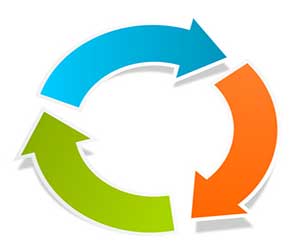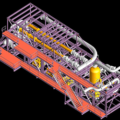
According to the Project Management Body of Knowledge (PMBOK), projects are divided into five phases. These phases are:
- Initiating. The project is authorized, funded and defined. This phase occurs on the organizational level (i.e. above the project). The organization defines a business need the project is meant to satisfy.
- Planning. The project manager develops a project management plan, which defines how the project will be carried out, who will do the work, how long it will take, and so forth. The project management plan must be approved by the project sponsor to become official, and changes must be re-approved according to the change management processes described therein.
- Execution. The project team gets to work producing the project’s deliverables.
- Monitoring & Controlling. The project manager ensures that the work is carried out according to the plan, and tracks deviations using earned value analysis for schedule and cost, as will as monitoring the scope, communications, vendors, and any other item necessary to ensure the project goes according to plan.
- Closing. The project must be officially closed, final details determined, vendors released, and so forth.
These phases are also called process groups, but I will try to use the term phase wherever possible.
In each phase, the project manager, or his team, produce several project management documents. These consist of:
| Phase | Project Documents |
|---|---|
| Initiating |
|
| Planning |
|
| Execution |
|
| Monitoring |
|
| Closing |
|
This is relatively basic list that would apply to small projects. In large projects where project management is a full time job, these documents will be supplemented by things like:
- Risk analysis
- Quality standards
- Project team job descriptions
- Communications plans
- Vendor terms of reference
Project Initiating
This phase includes the initial work necessary to create and authorize the project. In the PMBOK it contains only two processes:
- Develop Project Charter
- Identify Stakeholders
The project charter is developed by the performing organization but it can be delegated to the project manager. Its main purpose is to create the project and authorize the project manager. It contains whatever information is necessary to perform this function, but can also include things like:
- Scope statement
- Initial project budget allocation
- Primary stakeholders
Once the project has been initiated, the project manager proceeds into the planning phase.
Project Planning
This phase contains all 10 project knowledge areas within the PMBOK, and should not be underestimated. Project success is usually directly related to the amount of planning that has been performed. The primary project management document is called a Project Management Plan, and it contains the following information:
- Success Factors. The definition of project success is established. This usually includes schedule and budget, but often there are many other smaller factors that cannot be overlooked.
- Scope statement. The work that will be part of the project is identified, and its boundaries established.
- Deliverables. The products and/or services that the project will produce are listed.
- Schedule. The project is broken down into tasks. Timelines of each task are determined and deadlines for each project deliverable are determined.
- Budget. The estimated cost of each task is determined and rolled up into an overall project budget.
- Human resource plan. The project team roles and responsibilities are identified, and the method of acquisition for project team members is established.
- Quality management plan. The quality standards of the deliverables are identified and quality assurance and control metrics established.
- Risk management plan. The most important risks to the project success factors (#1) are determined and analyzed to ensure they can be managed.
- Procurement management plan. The external vendor needs are established and methods for acquisition and control of outside vendors established.
- Change procedures. The documentation and methods by which changes to the project management plan will be handled.
The project management plan should be approved by the project sponsor to kick off the project execution phase. From this point on, changes must be made through the project change control methods described within the plan, which normally should include a re-approval by the project sponsor.
Project Execution
In this phase the bulk of the project work takes place. The project manager directs and manages project work, and the project team carries it out. The project deliverables are produced and delivered to the project sponsor (or whomever they are produced for). The two key project management documents during this phase are:
- Project Status Updates. The project manager produces regular status updates according to the requirements of the project management plan. These updates generally include cost and schedule status as calculated by the earned value method.
- Stakeholder communications. Each stakeholder generally needs to be communicated with on their own terms with information specific to them. During project execution this communication is performed as outlined within the project management plan.
Monitoring and Controlling
This phase occurs concurrently and parallel to the project execution phase. The project manager must perform sufficient monitoring and control to ensure that the project’s deliverables are produced on time, on budget, and to sufficient quality.
The bulk of a project manager’s time in the project monitoring phase will be spent on a process called Earned Value Analysis. In this system the project manager calculates the project status from two standpoints: Schedule and Cost. It can be done at any time and can give you excellent advanced warning of the project going astray.
The variables calculated in this method are:
- Planned Value (PV), is the budgeted amount for each task at the specified point of analysis (usually today).
- Earned Value (EV), is the actual completion amount of each task relative to the task budget.
- Actual Cost (AC), is the actual expenditure for each task.
- Cost Variance (CV) is the amount that the project in a cost overrun or underrun position. CV = EV – AC
- Cost Performance Index (CPI) is the relative amount that the project is over or under budget. CPI = EV / AC.
- Schedule Variance (SV) is the amount that the project is behind or ahead of schedule. SV = EV – PV.
- Schedule Performance Index (SPI) is the relative amount that the project is ahead or behind schedule. SPI = EV / PV.
- More advance variables include Budget at Completion (BAC), Estimate at Completion (EAC), Variance at Completion (VAC), Estimate to Complete (ETC), and To Complete Performance Index (TCPI). Each of these variables is described in our Practical Guide to Earned Value Analysis.
Earned value analysis is instantaneous, that is, it will give you a project status right at the point of analysis. It is a “snapshot” of the project’s schedule and budget status at any given time.
If the monitoring of the project results in changes to the project management plan, the change control procedures outlined within the plan are implemented. For small projects this could be as simple as a “change log” form.
Project Closing
Interestingly, project closing is the phase that is most ignored (or minimized) by project managers. This is probably because there are generally budget issues to address and we don’t want to burden the project with more. Or maybe we just want to move on. But regardless of why, the project closing phase is extremely visible to the corporate executives and can have a major impact on the project managers career.
Closing the project has one project management deliverable: A final report. This report should have the following parts:
- Formal closure. Contracts are finalized, and the project is declared complete.
- Funding. The project’s final budget is confirmed and excess funding released into general revenue.
- Procurements. The project’s vendor contracts are finalized and completion certificates issued.
- Final Details. Documentation of actual work performed, as-built drawings, or other details that need to be filed away for future reference.
- Liabilities. Warranties, insurance coverage, and bonds need to be established and agreed to.
- Release of Resources. The project team, equipment and other resources need to be returned to their rightful place.
- Lessons Learned. Documentation of lessons learned during the project can be invaluable to future projects.











Leave a Reply